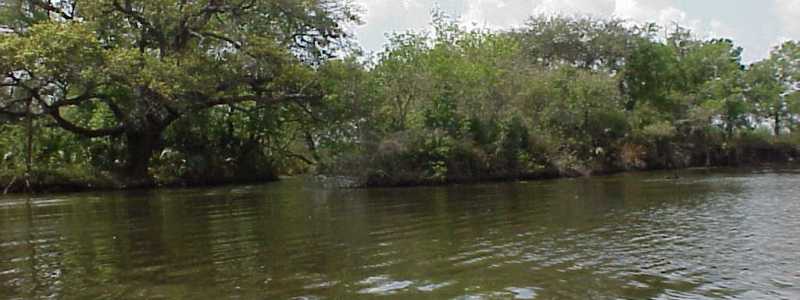|
Lavaca River |
|
| The Lavaca River rises in the far northeastern corner
of Gonzales County and flows southeast for 115 miles, crossing
Lavaca
and Jackson counties, to its mouth on Lavaca Bay in northern
Calhoun
County, 1½ miles north of Point Comfort. The river, which drains an area
of approximately 2,280 square miles, was originally described by René
Robert Cavelier, Sieur de La Salle, who named it Rivière de Les Veches,
or "Cow River," because of the buffalo in the area. The Spanish
translated the name to Lavaca. Even though the stream is classed as
intermittent because it depends on rainfall rather than permanent
springs for its water, the average annual flow is about 600,000
acre-feet, and heavy rains bring frequent flooding as far upstream as
Hallettsville. During the nineteenth century the river was normally
navigable to Texana, thirty miles above its mouth. According to legend
the Pride, flagship of pirate Jean Laffite's fleet, was
scuttled in the Lavaca near its mouth when pressured by an American
revenue cutter. |
|
| The Lavaca River flows by several towns,
including Moulton, Hallettsville, Edna, and Vanderbilt, but
its environs are used primarily for ranching and the
production of oil and gas from the numerous oilfields that
dot its banks. Its primary tributary is the
Navidad River,
which enters from the east two miles northeast of
Vanderbilt. The North Fork of the Lavaca River rises on the
Lavaca-Fayette county line and flows south through Lavaca
County for 7½ miles to its mouth on the main Lavaca River,
three miles southwest of Komensky. The loamy clay upland
soils of the area are easily eroded and are used primarily
for rangeland, pastureland, and the production of corn and
grain sorghum. Until the second half of the twentieth
century this area produced good yields of cotton, but soil
erosion and depletion encouraged many farmers to convert
their lands to pasture for beef and dairy cattle. The course
of the stream is marked with scattered oak, willow, and
sycamore, and unimproved pasture reverts to scattered cedar
and mesquite. |
|
| The West Prong of the Lavaca River rises
three miles southwest of Moulton in western Lavaca County
and flows east for 7½ miles to its mouth on the Lavaca
River, 1½ miles southeast of Moulton. It borders the south
and west sides of Moulton and flows through rolling hills
surfaced by well-drained loamy and clayey soils of generally
open upland prairie; the soils are used primarily for
rangeland, pastureland, and the production of corn and grain
sorghum. Occasional outcroppings of sandstone dot the area,
and on steeper slopes erosion is apt to be severe.
Vegetation consists of scattered oak, willow, and hackberry
mottes that provide cover for small game and upland birds.
The stream is used for recreation in Moulton. |
|
 |
|
|
Lavaca River |
|
|
Go To Top
Of Page! |
|





